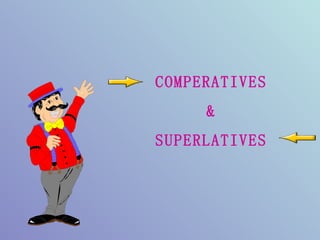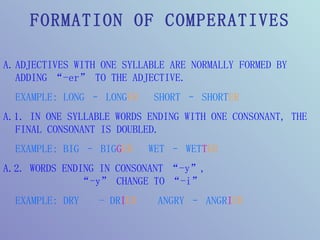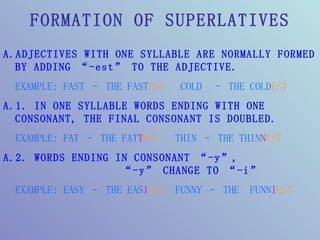Comparative and superlatives
- 3. WHY DO WE USE COMPERATIVES? WE USE COMPERATIVES TO COMPARE TWO OR MORE OBJECTS OR PEOPLE JOE: AGE: 25 1.85 cm 80 kg MIKE: AGE: 28 1.80 cm 65 kg TONY: AGE: 35 1.75 cm 100 kg Mike is older than Joe. Tony is heavier than Mike. Joe is taller than Tony. 4. Joe is younger than Mike 5. Mike is lighter than Tony. 6. Tony is shorter than Joe.
- 4. FORMATION OF COMPERATIVES ADJECTIVES WITH ONE SYLLABLE ARE NORMALLY FORMED BY ADDING ŌĆ£-erŌĆØ TO THE ADJECTIVE. EXAMPLE: LONG ŌĆō LONG ER SHORT ŌĆō SHORT ER A.1. IN ONE SYLLABLE WORDS ENDING WITH ONE CONSONANT, THE FINAL CONSONANT IS DOUBLED. EXAMPLE: BIG ŌĆō BIG G ER WET ŌĆō WET T ER A.2. WORDS ENDING IN CONSONANT ŌĆ£-yŌĆØ, ŌĆ£-yŌĆØ CHANGE TO ŌĆ£-iŌĆØ EXAMPLE: DRY - DR I ER ANGRY ŌĆō ANGR I ER
- 5. EXERCISES ON COMPERATIVES high fast busy sad young wise cute big clean short tall smart soft wet large
- 6. FORMATION OF COMPERATIVES B. ADJECTIVES WITH TWO OR MORE SYLLABLES ARE NORMALLY FORMED WITH MORE. EXAMPLE: MODERN ŌĆō MORE MODERN INTERESTING ŌĆō MORE INTERESTING BRILLIANT ŌĆō MORE BRILLIANT C. IRREGULAR ADJECTIVES : GOOD - BETTER BAD - WORSE SUMMER WINTER
- 7. EXERCISES ON COMPERATIVES difficult important careful handsome generous boring useful intelligent exciting fabuluous wonderful far bad old good
- 9. WHY DO WE USE SUPERLATIVES? WE USE SUPERLATIVES TO SHOW THE MAXIMUM AND THE MINIMUM DEGREES OF THE OBJECTS OR THE PEOPLE. MAX: AGE: 5 DRAGON: AGE: 3 CHUCKY: AGE: 2 Max is the oldest. Dragon is the strongest. Chucky is the youngest. 4. Dragon is the biggest. 5. Chucky is the funniest. 6. Max is the fattest.
- 10. FORMATION OF SUPERLATIVES ADJECTIVES WITH ONE SYLLABLE ARE NORMALLY FORMED BY ADDING ŌĆ£-estŌĆØ TO THE ADJECTIVE. EXAMPLE: FAST ŌĆō THE FAST EST COLD ŌĆō THE COLD EST A.1. IN ONE SYLLABLE WORDS ENDING WITH ONE CONSONANT, THE FINAL CONSONANT IS DOUBLED. EXAMPLE: FAT ŌĆō THE FAT T EST THIN ŌĆō THE THIN N EST A.2. WORDS ENDING IN CONSONANT ŌĆ£-yŌĆØ, ŌĆ£-yŌĆØ CHANGE TO ŌĆ£-iŌĆØ EXAMPLE: EASY ŌĆō THE EAS I EST FUNNY ŌĆō THE FUNN I EST
- 11. EXERCISES ON SUPERLATIVES high fast busy sad young wise cute big clean short tall smart soft wet large
- 12. FORMATION OF SUPERLATIVES B. ADJECTIVES WITH TWO OR MORE SYLLABLES ARE NORMALLY FORMED WITH THE MOST. EXAMPLE: EXPENSIVE ŌĆō THE MOST EXPENSIVE BEAUTIFUL ŌĆō THE MOST BEAUTIFUL PATIENT ŌĆō THE MOST PATIENT C. IRREGULAR ADJECTIVES : GOOD - BETTER - THE BEST BAD - WORSE - THE WORST
- 13. EXERCISES ON SUPERLATIVES difficult important careful handsome generous boring useful intelligen t exciting fabuluous wonderful far bad old good
- 15. EXERCISES ON COMPERATIVES & SUPERLATIVES 1. Joe is ________ than Ed. (short) 2. Al is the ________ . (short) 3. Ed is the ________ . (thin) 4. Joe is ________ than Al. (thin) 5. Al has the ________ clothes. (colourful) 6. Al is ________ than Joe. (heavy) 7. Ed is the ________ . (light) 8. Joe is ________ than Ed. (happy) 9. Ed is the ________ . (mysterious) 10.Joe is ________ than Ed. (energetic)














